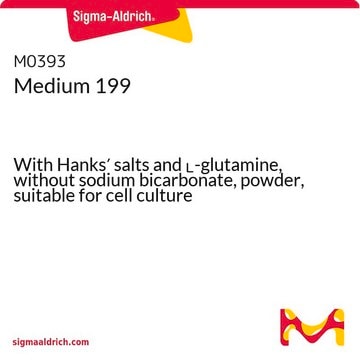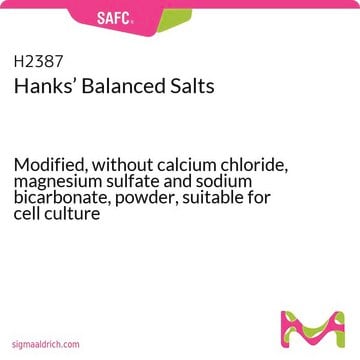M2520
Medium 199
HEPES Modification, with Earle′s salts, L-glutamine and 25 mM HEPES, without sodium bicarbonate, powder, suitable for cell culture
Synonym(s):
M199 Medium, TCM 199
Sign Into View Organizational & Contract Pricing
All Photos(1)
About This Item
UNSPSC Code:
12352207
NACRES:
NA.75
Recommended Products
Quality Level
form
powder
technique(s)
cell culture | mammalian: suitable
components
L-glutamine: yes
phenol red: yes
Earle’s salts (5% CO2): yes
NaHCO3: no
sodium pyruvate: no
HEPES: 25 mM
shipped in
ambient
storage temp.
2-8°C
Looking for similar products? Visit Product Comparison Guide
General description
Medium 199 is a combination of vitamins, amino acids, and other factors that were originally developed as a completely defined media formulation for the culture of primary explants. This medium, when properly supplemented has broad applicability, particularly for non-transformed cells. Medium 199 is widely used for vaccine production, in vitro cultivation of primary pancreatic explants, and lens tissues.
Application
Medium 199 has been used to:
- maintain the cumulus-oocyte complex (COC) before maturation and for culturing of these oocytes for in vitro maturation
- to rinse the aspiration line during the collection of the ovum from German Holstein cows
- to culture cardiac endothelial cells from rats
Quantity
Formulated to contain 14.7 grams of powder per liter of medium.
Reconstitution
Supplement with 2.2 g/L sodium bicarbonate.
also commonly purchased with this product
Product No.
Description
Pricing
Storage Class Code
11 - Combustible Solids
WGK
WGK 1
Flash Point(F)
Not applicable
Flash Point(C)
Not applicable
Certificates of Analysis (COA)
Search for Certificates of Analysis (COA) by entering the products Lot/Batch Number. Lot and Batch Numbers can be found on a product’s label following the words ‘Lot’ or ‘Batch’.
Already Own This Product?
Find documentation for the products that you have recently purchased in the Document Library.
Customers Also Viewed
Mao Ye et al.
Scientific reports, 4, 4681-4681 (2014-04-16)
The highly specialized endothelial cells in brain capillaries are a key component of the blood-brain barrier, forming a network of tight junctions that almost completely block paracellular transport. In contrast to vascular endothelial cells in other organs, we show that
Jarosław Wieczorek et al.
Animals : an open access journal from MDPI, 10(4) (2020-04-16)
The laparoscopic method of recovering oocytes in goats and sheep is one of the minimally invasive methods used in the biotechnology of animal reproduction. It allows for good quality oocytes that are suitable for in vitro maturation and fertilization to
In vitro nuclear maturation of bitch oocytes in the presence of polyvinyl-pyrrolidone
Animal Reproduction, 3(1), 70-75 (2018)
L González-Fernández et al.
Reproduction, fertility, and development, 30(2), 297-306 (2017-07-07)
Equine cumulus-oocyte complexes (COCs) are classified as compact (cCOC) or expanded (eCOC) and vary in their meiotic competence. This difference could be related to divergent glucose metabolism. To test this hypothesis in the present study, eCOCs, cCOCs and expanded or
Daniel L Villeneuve et al.
Environmental health perspectives, 117(4), 624-631 (2009-05-15)
Several chemicals in the environment have the potential to inhibit aromatase, an enzyme critical to estrogen synthesis. The objective of this study was to provide a detailed characterization of molecular and biochemical responses of female fathead minnows to a model
Our team of scientists has experience in all areas of research including Life Science, Material Science, Chemical Synthesis, Chromatography, Analytical and many others.
Contact Technical Service





